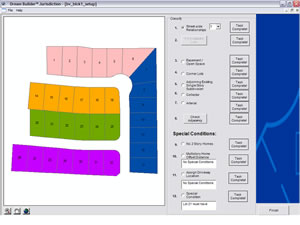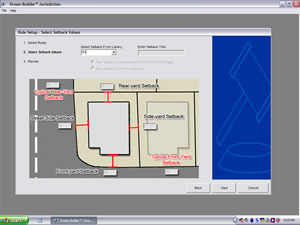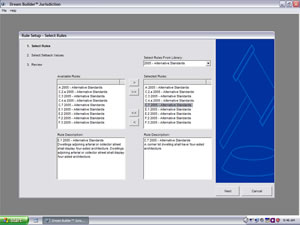Highlights
- Less time is required to review a permit.
- The system is simple enough for non-GIS-savvy users to operate daily.
- Planners can apply subdivision-, street-, and lot-specific rules.
Marana, one of the fastest-growing communities in southern Arizona, has expanded from 10 square miles in 1977 to more than 120 square miles today. Since 1997, Marana's population has grown 40 percent annually and now totals 35,000 residents. One of the town's greatest concerns was ensuring that this growth did not come at the expense of creativity and diversity in housing stock.
| |

A planner specifies how the jurisdiction's design standards will be applied to each lot. |
To guarantee that Marana would not become a landscape dominated with "cookie-cutter" homes, architectural design standards were adopted that forced home builders to construct aesthetically pleasing streetscapes that foster a sense of community among residents. These standards prohibited the monotony of garage-dominated front elevations, forced builders to vary the distribution of roofing materials, and limited the use of two-story floor plans, among other restrictions. While these standards did accomplish the goal of creating a more attractive community, they caused a significant amount of pain for the town's planning department.
As of 2005, 15 different architectural design standards needed to be met before a building permit could be approved by the town's planning department. Examples of these standards read: "No two models with the same elevation may be repeated more than one in five along a street side" and "No more than 40 percent of the lots in a subdivision shall have garages flush with or project in front of the livable space of a dwelling." Each of these standards forces a planner to not only look at the home itself but also the homes immediately adjacent to it, as well as the composition of the subdivision as a whole. This was not an easy task, seeing that subdivisions frequently hold more than 300 homes, not to mention the fact that there were more than 20 different subdivisions under construction. Reviewing a single permit against the town's design standards took more than 15 minutes.
| |

This diagram is used to define how setbacks will be evaluated in a particular subdivision. |
To solve this problem, Marana contacted Esri Business Partner the Planning Center, a Tucson, Arizona-based consulting firm, to create an electronic review system to enforce architectural design standard compliance. In response to the city's request, the Planning Center developed a software product it named Dream Builder Jurisdiction. The latest ArcGIS Engine platform was chosen by the Dream Builder developers to create a system that was simple enough for non-GIS-savvy users to efficiently operate on a day-to-day basis.
With ArcGIS Engine, the developers were able to spatially represent the combination of data from the town's permit-tracking system and its existing GIS database, the end product being an electronic subdivision map to which planners can then apply subdivision-, street-, and lot-specific rules.
| |

Dream Builder allows jurisdictions to evaluate separate sets of standards on multiple subdivisions without confusion. |
To begin the review process, the Marana GIS department takes a newly submitted builder's CAD subdivision layout and converts it to a georeferenced database file. Once this file is created, the planning department can begin setting up the rules that apply to that particular subdivision. The entire procedure required to set up a subdivision for review takes anywhere from 15 to 30 minutes, depending on how many lots the subdivision contains. From this point on, the permit review process is nearly instantaneous. The planner simply enters a permit tracking number, selects the lot's proper left/right orientation, and hits the submit function. Within a fraction of a second, the characteristics of the planned construction are checked against the rules of the subdivision and a report is generated with a detailed checklist of which standards are in compliance and which ones are in violation.
The automated system not only reduces the time required to review a permit but also ensures that rules are being enforced consistently across planning staff. So far, the reviews have been overwhelmingly positive. "The town is no longer susceptible to building permits stacking up due to bottlenecks associated with individual project planners being out of the office," says assistant planning director Lisa Shafer. "The average time to review a permit for design standard compliance is now under 30 seconds."
More Information
For more information, contact Kevin Kish, Town of Marana planning director (tel.: 520-382-2600), or Aaron Einfrank, the Planning Center's Dream Builder Department (tel.: 520-623-6146).
|